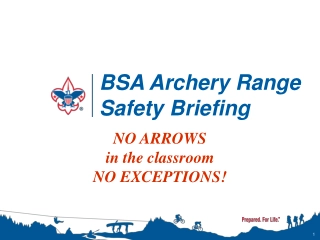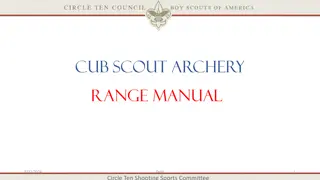Promoting Archery in Hillingdon: Understanding Scoring and Rules
Learn about the scoring system in archery, including point values, line cutters, outdoor shooting details, and indoor scoring rules. Discover how the standard 5-colour face, outdoor rounds, and indoor rounds are scored correctly. Enhance your knowledge on Imperial and Metric scoring systems and the importance of accuracy in recording scores.
Download Presentation

Please find below an Image/Link to download the presentation.
The content on the website is provided AS IS for your information and personal use only. It may not be sold, licensed, or shared on other websites without obtaining consent from the author.If you encounter any issues during the download, it is possible that the publisher has removed the file from their server.
You are allowed to download the files provided on this website for personal or commercial use, subject to the condition that they are used lawfully. All files are the property of their respective owners.
The content on the website is provided AS IS for your information and personal use only. It may not be sold, licensed, or shared on other websites without obtaining consent from the author.
E N D
Presentation Transcript
To promote and encourage the sport of Archery within Hillingdon Scoring Correctly
Point Values The number of points awarded for hitting a specific colour or "ring" on a target depends on several factors whether you are shooting indoors or outdoors whether you are shooting an Imperial or Metric round This may look complicated at first there are really only two main systems to learn - Imperial or Metric (with a very slight variation between the indoor and outdoor Metric scores).
Line Cutters One thing is common to all the scoring systems and round types. If your arrow cuts the line between two of the rings, however slightly, you always get the higher score
Outdoor Shooting Target Faces Outdoor rounds are always shot on the standard 5 colour face. The face can be either 122cm or 80cm across, depending on the type of round being shot. All Imperial Rounds (those shown in yards e.g. Windsor, Albion, National etc.) are all shot on the 122cm face. Metric rounds (those shown in metres e.g. Short Metric I etc.) may be shot on either the 122cm face, the 80cm face or a combination of both, depending on the round.
Outdoor Scoring This is the only system where the innermost gold counts as 10 points but is marked as an X on the scorecard. The number of Xs is used to resolve tie breaks. Outdoor - Scoring GNAS Imperial Rounds Outdoor - Scoring FITA and GNAS Metric Rounds DO NOT under any circumstances amend an arrow value if it is called or written wrongly, call a Judge. You may make any correction necessary to additions and totals without the need to call the Judge. If you are scoring repeat the score called, before writing it down to ensure you heard it correctly.
Indoor Scoring All indoor rounds shot with a recurve use the Abbove 1-10 scoring system where the both the inner and innermost gold's count as 10. scoring for compounds indoor, which is slightly different to R/C i.e only the inner ring scores 10 for compound (at some time your may be on the same target as a compound archer doing a Portsmouth round) X's are not recorded on any indoor rounds. A lot of people do record X's in a Portsmouth this is wrong. Indoor - Worcester Round The indoor Worcester round is an exception to the coloured scoring faces. It is shot on a special target with 4 black outer rings and a white inner ring. The outer rings score 1-4 with the inner ring scoring five. It is also the only round where you shoot 5 arrows per end. DO NOT under any circumstances amend an arrow value if it is called or written wrongly, call a Judge. You may make any correction necessary to additions and totals without the need to call the Judge. If you are scoring repeat the score called, before writing it down to ensure you heard it correctly.
Indoor Shooting Target Faces Again, most of the Metric (shown in metres) and Imperial (shown in yards) are shot on the standard 5 colour face. The face may be 80cm, 60cm or 40cm depending on the round. There is also a special black and white face which is only ever used in shooting the Worcester round. This has a possible score range of 1-5 Worcester round the targets are set one above the other and you change targets top & bottom after 2 1/2 dozen arrows, also 'A' details start on the top target with B on the bottom. (tip: - you need to have 6 arrows in your quiver in case of a bouncer).
The Score pad Regardless of the type of round you are shooting or the brand of score pad you are using your score is recorded in a similar way. Every time you collect your arrows, your scores are recorded from highest to lowest. For example if your three indoor arrows scored a 4 and two 8s you would record this as 8,8,4. If your next three scored two 5s and a 9 you would record this as 9,5,5 and your scores would read 8,8,4,9,5,5. If six outdoor arrows scored three 9s, a miss, a 5 and a 3 you would record this as 9,9,9,5,3,M. Write these from left to right in the boxes provided. Each "End" (six arrows) add up the score for those six arrows and write it in the "End" box. Repeat the process for the next six arrows. Add up the number of "Hits" (i.e. scoring arrows only) for those twelve arrows and write that in the "H" box. Add up the number of "Gold's" (i.e. 9s on Imperial scoring and 10s on Metric) for those twelve arrows and write that in the "G" box. Add up the score for both the "Ends" on that line (i.e. the total score for the twelve arrows) and write that in the "Dozen" box. The final box on the line is the "R/T" or Running Total which for the first line is the same as the "Dozen" figure. Continues on Next Page
In competition it is normal for Archer C to be the target captain and archer D to be the lieutenant and scorer unless there is an agreement between the archers i.e. a volunteer (this may be desirable if an archer has difficulty in pulling arrows). For an outdoor FITA round you don't record Hits, just arrow value, 10's and X10's NO RED PENS may be used. this is only for judges and field captains for corrections to arrow values. DO NOT under any circumstances amend an arrow value if it is called or written wrongly, call a Judge. You may make any correction necessary to additions and totals without the need to call the Judge. If you are scoring repeat the score called, before writing it down to ensure you heard it correctly.
That completes your scoring for your first dozen arrows and finishes the first line of your score sheet. Repeat these steps for the next dozen arrows to complete the second line. This time your "R/T" running total will be the sum of the first two "Dozen" scores. Repeat the process for the correct number of arrows in the round you are shooting. Once you have finished the required number of arrows, add up the total number of Hits and Gold's and record these, together with your total score, in the appropriate "Totals" boxes at the bottom of the sheet
A few basic but important notes (especially for competitions!) Don't touch the arrows or the target face until all the arrows have been recorded. Point to the arrow nocks as you call each arrow. If you are calling out your scores for someone else to record (e.g. a competition), call them in batches of three, e.g. 9,9,9 (pause) 5,3,Miss. If there is any sort of dispute over the score of an arrow that the archers on the target can't agree on, don't pull any arrows until the field captain or judge has been called and made their decision. Complete the scoring before collecting any arrows that overshot the target (obviously collect any that fell short as you approach the target - before someone stands on them!) Make sure all the final boxes are filled in i.e. Total Hits, Golds, Score. On an Imperial round if there are an even number of hits, the total score should be an even number and vice versa if an odd number of hits. If the score card is incorrect it may be disqualified. If after you sign it you find you have scored more than you have signed for, it is too late. That s why most archers keep their own scores as well. THE OFFICIAL SCORE CARD TAKES PREFERENCE Remember if you sign to confirm you agree with your scorer that your score is correct then that s the score that counts NO adjustments can be made once handed to the competition organizer. (This excludes Club League Table) arrows must be marked so they can be identified, usually with the archers initials on the shaft not the fletches.
Bouncers in Competitions: If your first arrow is a bouncer, continue shooting your 2nd and 3rd arrows then step back off the line and raise your bow in the air to attract the Judge/Field Captains attention. They will allow you to shoot a 4th arrow having marked it. They will then follow you to the target to ensure that your 1st arrow did in fact bounce off the scoring zone. (bouncers off the non scoring zone . boss / stand do not count and your 4th arrow will be disqualified. I have been to one shoot where you had to declare, on the entry form, the colour of your nocks and fletches. This was to avoid identical arrows shooting on the same target. For major competitions arrows must be marked so they can be identified, usually with the archers initials on the shaft not the fletches.
4 big difference between a GNAS York / Hereford round and a Fita Star round in a Fita star there are no sighters. there is instead a practice period usually 30-45 minutes during which you can shoot as many arrows as you wish withing the 2 minute time limit. The shooting time 2.5 minutes per 3 arrows is controlled by lights and hooters There is a double whistle / hooter to approach the line. Then a second single whistle / hooter to commence shooting. Then a triple whistle / hooter to stop shooting. Any arrows shot before or after the whistle will be disqualified. Every arrow hole must be marked before the arrows are pulled.
Thanks For Listening Remember if you sign to confirm you agree with your scorer that your score is correct then that s the score that counts NO adjustments can be made once handed to the competition organizer. (This excludes Club League Table) Good Shooting to you ALL!!!!























